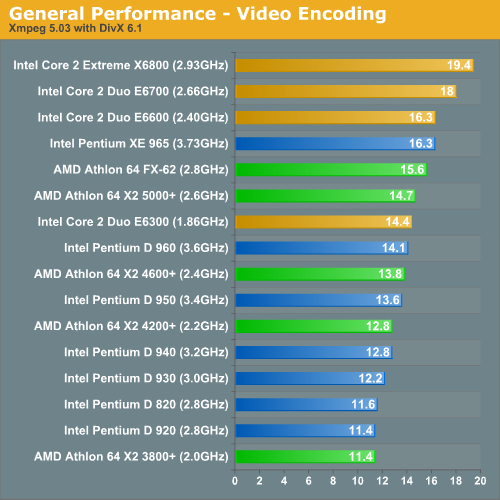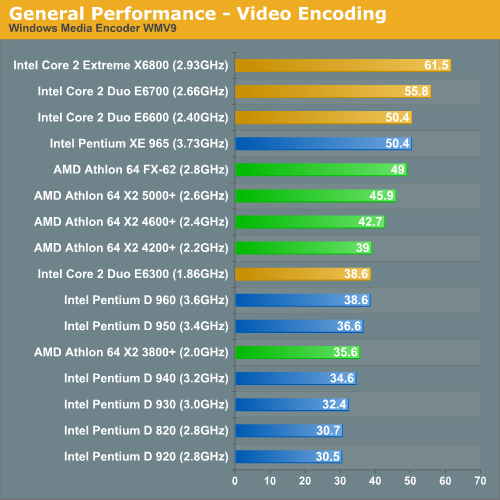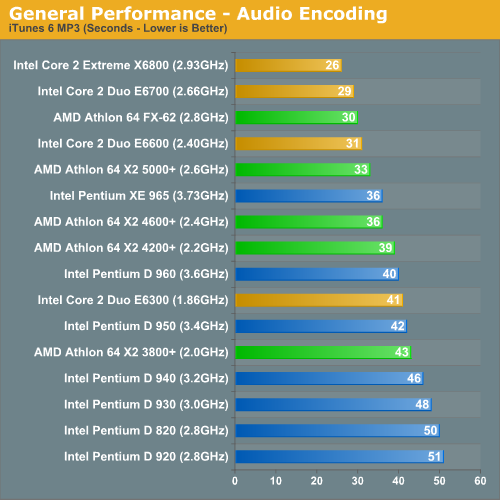Intel's Core 2 Extreme & Core 2 Duo: The Empire Strikes Back
by Anand Lal Shimpi on July 14, 2006 12:00 AM EST- Posted in
- CPUs
Encoding Performance using DivX 6.1, WME9, Quicktime (H.264) & iTunes
Multimedia encoding is typically a very good CPU benchmark, with performance that scales very nearly linearly with faster CPU clock speeds. Video testing was conducted using three popular codecs and applications: Xmpeg 5.03 with DivX 6.1, Windows Media Encoder with WMV9, and QuickTime 7.1 with H.264. The complexity of the encoding process increases as we move from DivX to WMV9, and H.264 encoding is in a league of its own in terms of the amount of CPU time required.



In something of a change, both the Core 2 Extreme and that E6300 manage roughly a 25% margin of victory over their AMD counterparts in the DivX test. The E6300 very nearly matches the X2 5000+ here. The X6800 maintains the 25% lead in WMV9, while the E6300 lead over the X2 3800+ drops to 8.5%, roughly equaling the 4200+. Finally, in H.264 encoding, the Core 2 Extreme claims one of its largest victories coming in 36% faster than the Athlon FX-62; the E6300 also manages a large 21% performance lead over the X2 3800+ and falls between the 4600+ and 5000+ in performance.

Moving over to audio encoding performance, we used Apple's iTunes 6 application to encode a single 307 MB Wav file into a 192kbps MP3. Audio encoding is still very CPU intensive, but of course the faster encoding times make the differences less noticeable in practical use. At the top and bottom price points, Intel leads again: 5% at the low-end, and 15% at the extreme performance segment. Unless you frequently encode really large amounts of audio files, however, it's unlikely you're going to notice Intel's 2-4 second lead.










202 Comments
View All Comments
MrKaz - Friday, July 14, 2006 - link
So how do you calculate performance/watt?Based on Doom3? Quake4? Lame? PowerDVD? Divx encoding?
My point is, this is "impossible" to do, unless you do it for all progs and games.
Picking up just one of them is being biased...
JarredWalton - Friday, July 14, 2006 - link
Including performance/watt on *ANY* game is a bit odd, given that the GPU will comsume more power than the CPU. That's why when we talk about performance per watt on GPUs, we use the same platform for all tested systems.If we're going to talk about performance per watt and we're worried about the CPU and platform, then we should look at benchmarks that stress that portion of the system more than anything else. In fact, you could argue that we should drop down to the lowest power GPU possible, or even go with an integrated graphics solution. Anyway, here are a few of the results using WME9:
0.358 FPS/W X6800
0.319 FPS/W E6600
0.279 FPS/W 4600+ EE
0.276 FPS/W 3800+ EE
0.273 FPS/W 5000+
0.244 FPS/W FX-62
0.244 FPS/W E6300
0.228 FPS/W PD XE 965
Part of the reasons on the lower performance Core 2 Duo chips score so poorly is because we are measuring Watts of the entire system. It's reasonable to say that the motherboard, hard drives, graphics card, etc. probably use up on average 100 W of power, give or take. The AMD motherboard and peripherals might also use a bit less power than than the Intel board, or vice versa, so the 12 W difference in power draw at idle shouldn't be considered really significant.
What is significant is that other than the two energy efficient AMD chips (which you can't yet purchase on the retail market), Core 2 offers better performance per watt at similar price points. We could go and measure performance per watt on a bunch of the other applications (even games, though the differences are going to be greatly diminished given the GPUs requirements), but the results really aren't likely to change much. Core 2 is faster than AMD, and at worst it matches AMD's power requirements; ergo Core 2 offers better performance for watt.
epsilonparadox - Friday, July 14, 2006 - link
Intel didn't start the focus on performance by watt. AMD started it and ruled the charts based on that measure. Every single X2 vs P4D review has a chart for that measurement. Intel w/ the C2D just turned the table back on them by harping on the same issue. If this measurement didn't become a big deal, you'd likely be running dual 1000W psus to run dual core/multi gpu setups.Furen - Friday, July 14, 2006 - link
It's hard to do a performance/watt chart because processors perform differently under different applications. I'm sure you'll agree with the fact that the E6600 is much faster than an X2 3800+ yet draws only slightly more power.bupkus - Friday, July 14, 2006 - link
: (Where's the pics?
My browser doesn't show them on the first page.
Gary Key - Friday, July 14, 2006 - link
What browser?bupkus - Friday, July 14, 2006 - link
FirefoxGary Key - Friday, July 14, 2006 - link
I have tried three different versions of FireFox on varying machines without an issue so far. Still looking in to it.JarredWalton - Friday, July 14, 2006 - link
Options ->Web features ->
Load Images ->
UNCHECK "for the originating web site only"
ianwhthse - Friday, July 14, 2006 - link
Mine is already unchecked, however I cannot see the pictures either. [Firefox]Kicking and screaming, which is somewhat disruptive @4am, I opened Internet Explorer and I cannot see the images there, either.